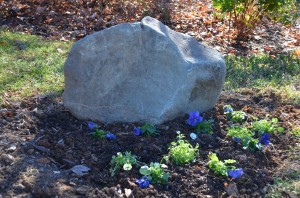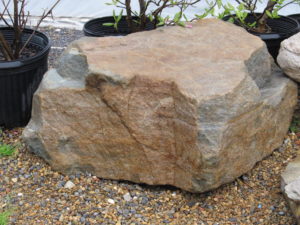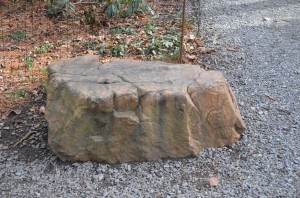A well placed landscape rock or boulder is a perfect garden feature. Planted properly, the boulder appears to emerge naturally from the bowels of the earth. The crowning achievement is when mosses and lichens find a home in its crevices or when vines crawl over them.
Boulders may exhibit seams of color(s), deep crevices, and/or have jagged or rounded edges. Is the rock, stone , or boulder best displayed from a vertical or horizontal position? Boulder may provide multiple landscape uses from a child climbing over it or the gardener looking for a comfortable sitting stool.
A recent addition to our garden is a 250 pound rock (photo on left). Our stone has a broad muscular base and a flat gray/blue face (side facing the street). On rainy day the darker blue color comes forth. A couple of strong friends help move, orient, and set the rock in its permanent spot. We “posed” our rock, turning it to catch its showiest side(s) from inside the home and curbside. Neighbors, joggers and and dog walkers get to view the muscular side from curbside.
A wide shallow hole was dug around the base to “root” and support the boulder firmly. Plant your rock shallow! Its mass (bulk) and weight, along with gravity, will eventually settle a heavier boulder deep. On soft ground, add 2-4 inches of gravel or sand and tamp it down for firmer base. Be absolutely certain that the rock is firmly anchored and will not tip or roll and hurt a young child climbing over it.
Around the rock you may wish to plant low growing plants such as pansies, flowering bulbs, sedums, coral bells, cranesbills, astilbes, or ferns.




 Posted in
Posted in 
